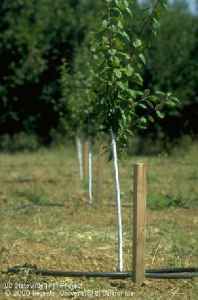If you are planning a prune orchard in the near future, here’s something to think about. Prune farming is about turning sunlight into sugar: the more sunlight your trees “catch” per acre, the greater the potential crop production. Driving around the Sacramento Valley and looking at prune orchards compared to walnuts, almonds and peaches, I bet you’ll see that on average most current prune plantings allow more sunlight on the orchard floor – and so leave more money per acre on the table — than any other major tree crop in the Sacramento Valley.

New prune plantings should consider maximizing the amount of sunlight captured by the canopy.
Most prune growers are already moving to higher density plantings. Prune orchard planting distances have shrunk from 20’ x 20’ several decades ago to somewhere in the range of 18’ wide by 14’ to 16’ between trees in many orchards. Many growers with older 20’ x 20’ plantings are interplanting down the row, thus turning their orchards into 10’ x 20’ plantings. Once the trees are touching and shade is solid down the row, crop potential is maxed out in that direction. If there is more cropping potential in a prune orchard design, it’s in the row middles.
If you look down the rows of your current prune planting(s) and see 2-4 feet of sunlight between the tree canopies, keep that in mind when planning a new orchard. If you currently produce 3 dry tons of prunes per acre with an 18’ across x 16’ down the row planting, that’s 40 lbs of fruit production per tree at 151 trees per acre. That same orchard should produce 3.17 dry tons/acre if planted 17’ across x 16’ by down the row (160 trees/acre) and 3.38 dry tons/acre at 16’ x 16’ (170 trees/acre). At those tighter plantings, the only difference is that there would be less sunlight growing weeds in the orchard middles. At $2000/ton average dry fruit price to grower, that’s an additional $352 (17’ x 16’) to $760 (16’ x 16’) per acre gross return with tighter across-the-row planting. For a 50 acre orchard, that’s $19,000 to $38,000 more PER YEAR than an 18’ x 16’ planting for simply planting 10-20 more trees per acre. No risky new practices, variety or rootstock, just a tighter planting catching more sunlight.
Narrower middles will mean tighter working conditions for harvesters. Several manufacturers I’ve spoken with prefer a minimum row width of 18’ to give good equipment access, although I’ve been told by at least one major manufacturer that their equipment could work in an orchard with 15’ across the row spacing.
Equipment size shouldn’t dictate grower income potential. There are several things growers can do when planning and growing a prune orchard to improve harvester access. First, plant the orchard on an offset square pattern: it’s easier to harvest (the shaker driver won’t have branches from the tree in the next row over in their ear when shaking each tree down the row) and there is more space for each tree in the row compared to the same tree density planted on a square pattern. Second, prune the trees to a more upright shape, not as spreading as a peach orchard. More upright trees have less sunburn risk than those having scaffolds with wide spreading, flat angles.
Net income determines orchard profitability. With land, labor and input costs rising, income will need to rise to keep prune growers in business. Increased light interception per acre, perhaps delivered by tighter plantings on current rootstocks (or larger trees on new rootstocks) should increase production per acre. While every grower must consider their own soil and equipment options when laying out a new orchard, tighter plantings should be part of the planning conversation.


Leave a Reply